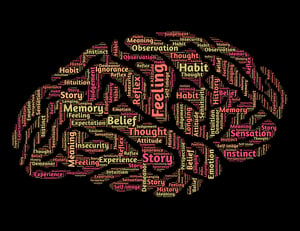The National Nanotechnology Initiative defines nanotechnology as the manipulation of matter with at...
Improving Innovative Thinking Using This One Mental Trick
Most people can address and resolve simple problems consciously. Complex problems, however, are more difficult to address. If we think about them too long, we could actually make the wrong decision. One of the reasons for this is humans have “bounded rationality.”
Bounded rationality has to do with three unavoidable constraints on decision-making, regardless of the intelligence of the decision-maker.
- The information a person has in order to make a choice is limited and often unreliable, relative to possible alternatives and consequences.
- The human mind has a limited capacity for evaluating and processing information.
- Time is always a factor for decision-making, often hindering options for the best possible outcomes.
Together, these deterrents lead most people to a satisficing choice, rather than an optimal one. Satisficing decisions are ones where the decision-maker strives for satisfactory, or “ok,” decisions that are just adequate to tackle a particular situation.
As helpful as bounded rationality is to survival, it hinders the human mind and intuition. A better way to solve complex problems is to let the unconscious mind choose.
Conscious Thought vs. Unconscious Thought
Conscious thought is linear and convergent; unconscious thought is non-linear and divergent. American Psychologist, J.P. Guilford, was the first to propose the concepts of convergent and divergent thinking while studying how different people responded to different types of problems. After conducting extensive research of human intelligence and problem solving, Guilford found that most people have a preference for either divergent or convergent thinking, rather than an even mix of the two types.
Speed, accuracy, and logic are the main characteristics of conscious thought. The primary objective is to arrive at the best and most logical conclusion in the least possible time. Convergent thinkers accumulate knowledge, learning strategies and techniques they can replicate in future situations. As such, they tend to be linear thinkers (linear means “like a line”). That is, their thought process follows known cycles or a step-by-step progression. A simple illustration of linear thinking is, if a=b and b=c, then a=c.
Relying too heavily on logic can be problematic since it needs a starting point. That starting point determines the set of logical conclusions to be considered. But, starting points can be limiting and even false, preventing a person from finding a better answer. For example, if a manager tells an employee to propose ways to increase profits through more sales, the employee likely will ignore potentially less expensive and demanding alternatives, like cost-cutting to increase profits. The manager has set the “starting point” and limited solutions to ideas that generate additional sales revenue. Convergent, linear thinkers are not adept at creative problem-solving for subjective or unfamiliar issues.
In contrast, unconscious thought occurs when conscious thought is diverted elsewhere. An example of unconscious thought is when someone in the market for a new car researches several options, narrows the choices to three, completely forgets about the decision (goes off to play golf or distracts themselves with something else), and then makes a decision based on which choice is at the top of his or her mind.
Unconscious thought requires divergent, non-linear thinking to look at the problem from several different angles. The focus is on information-gathering from a variety of sources and disciplines. Consequently, there are multiple starting points. This approach is less constrictive due to its inherent lack of structure. Whereas the linear approach requires progression through the decision-making steps, non-linear thinking encourages problem-solvers to jump forward and from side-to-side, seeing the big picture and the multiple starting points.
Divergent thinkers excel at open-ended problems with many possible options. They tend to be more resourceful and less logical than convergent thinkers. In short, divergent thinking isn’t thinking out of the box; it’s thinking without the box. The goal is to generate many different ideas in a short amount of time by breaking down the topic into component parts, with ideas coming in a spontaneous, random, and unorganized fashion. The best divergent thinkers exhibit personality traits such as nonconformity, curiosity, willingness to take risks, and persistence.

The Benefits of Unconscious Thought
There are many benefits to divergent thinking, especially in the contemporary work environment where employers are emphasizing experience over knowledge. A Cornell University study in 2012 found that divergent thinking improves language proficiency and performance. Another study conducted in the Netherlands revealed that divergent thinking leads to positive mood swings, while convergent thinking leads to negative mood swings. Other research shows a positive correlation between divergent thinking and entrepreneurial potential and creativity, and a negative correlation with comprehending emotions, suggesting that people think most divergently when their perspective isn’t colored by emotion. Researchers at Kalyani University in India determined that people with more complex analytic cognitive structures show a greater capacity for divergent thinking, as do those with a high self-concept and scholastic achievement.
Further, divergent thinking drives real innovation because innovation is transformational, not transactional. An organization that masters innovation is one where employee engagement, ideation, and change readiness have “gone viral.” There are no pre-determined starting points—just a problem to address, and the right resources (human and otherwise) to enable agile testing and experimentation.
The right people for innovative initiatives are divergent thinkers; and the best managers for driving innovation define the business need, not the starting point, and then step aside to manage the chaos. Interestingly, left-handers tend to excel in ideation, conceptualization, trend-setting, and social interactions. Lefties may have an innate edge in business environments that value innovation, creative solutions, and customer-centric goals.
How to Practice Unconscious Thought Theory
To those who are not left-handed, there is no need to give up! It is possible to learn divergent thinking. Saga Briggs, Managing Editor of InformED, offers several suggestions for individuals and groups.
1. Fast, frequent failures. Making as many mistakes as possible as quickly as possible means you’re heading swiftly towards the right solution to a problem. Learn to be comfortable in “flash bulb” team sessions where colleagues lay out all possible solutions in front of each other.
2. Use Google. Google allows you to spend more time thinking about deeper questions since it provides instant answers to the shallow questions.
3. Solve the right problem. When solving a difficult problem, start with the most basic phrasing of the issue. Keep it simple rather than diving down a rabbit hole of “cause and effect.” The farther one gets from an initial problem, the more difficult it becomes to measure a solution.
4. Respond to curiosity when it arises. Answer questions that may come to mind now, not later, while the curiosity is still burning. This is when divergent thinking has the highest chance of cultivating creative thinking.
5. Encourage numbers and defer judgment. Collect data, run an analysis, and gather every possible idea. Defer all judgment until fact findings are complete.
6. Support the strange. Consider unusual solutions and explore different perspectives. After all, history’s most notable inventions were considered strange and even crazy prior to their mass adoption.
7. Combine ideas. Look for combinations of ideas that might work together. Build from the ideas of others. It’s so cliché, but teamwork makes the dream work. And everyone is usually better off for it.
8. Create the right environment. Divergent thinking is more likely to thrive in an environment that permits different types of expression, encourages risk, and allows failure.
9. Engage in brainstorming. In group sessions, spontaneously contribute ideas in response to a well-crafted problem statement. Forget formalities, just let the conversation flow.
10. Substitute. Explore alternatives to materials, processes, and methods already in use.
11. Adapt. Can something already in use be adapted?
12. Eliminate. Think in terms of removing, not adding. What can you do to eliminate problems and inefficiencies? What materials, methods, and steps can be eliminated?
13. Brainwrite. Have people brainstorm first on sticky notes or index cards without speaking to each other. This encourages everyone to be heard and prevents people from forgetting their ideas as they wait for an opportunity to speak. Then, have them share their ideas and build upon them together.
14. Six Thinking Hats. Pioneered by Edward de Bono, the Six Thinking Hats exercise encourages parallel thinking, or viewing a problem from different perspectives depending on which “hat” you’re wearing. This seemingly silly exercise forces individuals to play devil’s advocate, opening new pathways in their thinking process.
15. Be provocative. Start with a provocative position on the problem and then examine the consequences of the statement, potential benefits, circumstances in which the statement describes a good solution, and resources needed to make the idea work. Next, change the parameters of the idea and begin the process again.
16. Use technology. Technology like Youtongo or other brainstorming platforms offer some exciting ways to complement and enhance divergent thinking techniques.
After honing divergent thinking skills, it’s time to tap into the power of the unconscious mind to solve complex problems. Meditation is one way to do that. Science proves meditation relieves stress, boosts creativity, refreshes mental power, and attracts a new thought process. The purpose of meditation is to slow each of the five major categories of brain waves. In doing that, the time gap between incoming thoughts widens, allowing the mind to slow down, which enhances clarity and decision-making skills.

Practicing meditation doesn’t need to be elaborate or ritualistic. The basis is to just focus on the breath. Breathe in, breathe out. Focus on the “here and now,” observing the present moment with all of your senses. And when thoughts of anything else pop come to mind, simply bring awareness back to breathing. If focusing on the breath doesn’t work for you, use words. In your mind or out loud, repeat something that has personal meaning to you. The phrase should be simple and pull your awareness into the present moment. Some examples of these mantras are:
- Just breathe
- Breathe in, breathe out
- I am present
- Sat Nam (meaning “true identity” in Sanskrit)
See, Speak, and Write Your Way to Better Decisions
Another problem-solving technique is visualization, or imagining. In your mind, picture the best possible outcome or scenario. Athletes use visualization frequently to imagine perfect performances. Eventually, thoughts and the overall mindset move in the direction of that which it visualizes. A “vision board” can help focus thoughts on the end goals by displaying a collection of pictures that trigger and strengthen unconscious thought.
A frequently underestimated technique is affirmations. An affirmation is a “pep talk” with yourself that can boost focus and ambition. The success of this method depends on consistent use and associated feelings. Some people continue the practice only for a day or two and then stop, getting caught up in the business of their daily lives. Others just practice affirmation for the sake of doing it and/or they ignore their feelings in the process. If you never get to feel the emotions from affirmation, you will never make it work. Connect the emotions to the experience by repeating the affirmations as many times as you need, making sure to do it reach day.
The ability to get out of your comfort zone is a powerful trigger of the unconscious mind. You can experience exponential growth from doing things out of your norm. For example, studies have proved that when a person travels to a place where s/he has never been, the brain creates new neural pathways as neurons connect with each other in a new way. Additionally, when you do and experience something new, you expand your comfort zone, reprogramming your unconscious mind. Even trying new foods, altering your daily routine, or reading different books can help set your mind on a new path.

Finally, consider practicing free writing. Writers and authors frequently use this technique to overcome writer’s block, but anyone can use it. The process involves writing your thoughts on paper. When done daily, free writing causes you to acknowledge roadblocks, problems, and obstacles and, in turn, to clear your mind and free your emotions from mind clutter. For some, free writing actually makes them more relaxed than meditation. In the process of committing thoughts to paper, you can become more creative, strengthen your creative muscles, and understand yourself better.
While conscious thought is sufficient for simple problems, the best results from complex problem-solving come from harnessing the power of the unconscious mind and divergent thinking. Practicing new techniques and developing new habits offers more than just a satisficing solution.
Creative problem-solving is easier than you think! Download our ebook to discover more ways to "think without the box."




